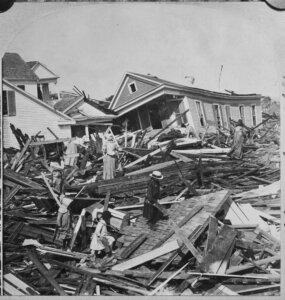In Galveston, Texas, a refuge for Jews escaping pogroms — and perhaps a lesson for today’s ‘migrant crisis’
For Jewish immigrants, Galveston was once ‘the Ellis Island of the West’

A postcard from Galveston, Texas, circa 1940. Photo by Getty Images
In 1907, the port of Galveston, scarcely recovered from the Great Storm of 1900, faced a very different kind of disaster — one of an even greater magnitude.
Unlike the hurricane, though, this one was man-made. Between the late 19th and early 20th centuries, a series of pogroms — organized and spontaneous massacres of Jews — erupted across eastern Europe and Russia, unleashing an unprecedented population movement. Between 1881 and 1924 more than two million Jews, fleeing for their lives, immigrated to the United States.
Tired and poor, these immigrants settled in or near New York or the other eastern seaports where they arrived. Increasingly, though, rather than being welcomed, they were warned to stay away. Typical was the response of the Reverend A.E. Patton after a visit to Ellis Island, who was repelled by “the Jewish hordes, ignorant of all patriotism, filthy, vermin-infested, stealthy and furtive in manner, too lazy to enter into real labor, too cowardly to face frontier life.”
For some Americans, this was not the human material with which to keep America great. As this racist rhetoric became commonplace, American Jewish leaders grew frantic. They feared that the massive influx of their East European brethren, so very different in look and language from they themselves, would fan the flames of American nativism and lead to a more restrictive immigration policy.
It was not just run-of-the mill racists like Patton who recoiled at the prospect of even greater waves of immigration from eastern Europe. The novelist Henry James, having just returned to New York from London, was shocked by its changed character. “There is no swarming like that of Israel when once Israel has got a start, and the scene here bristled, at every step, with the signs and sounds, immitigable, unmistakable, of a Jewry that had burst all bounds. What he described as the “the gathered past of Israel pushing through” foretold, in his eyes, the “Hebrew conquest of New York.”
Though on the opposite side of the political and ideological divide, the social reformer Jacob Riis nevertheless echoed, if not adhered to James’ racist stereotypes. In 1890, he published How the Other Half Lives, a detailed and devastating account of the tenements of New York City. One of the chapters, titled “Jewtown,” captures both the powerful and problematic nature of Riis’ approach: “No need of asking here where we are. The jargon of the street, the signs of the sidewalk, the manner and dress of the people, their unmistakable physiognomy betray their race at every step.”
What was to be done? Perhaps what one historian has called “the Ellis Island of the West” held the answer. The so-called Galveston Movement was hatched by a handful of memorable individuals: the New York philanthropist Jacob Schiff, the British writer Israel Zangwill, and the Galveston rabbi Henry Cohen. Committed to Americanizing these immigrants from eastern European, this remarkable trio in effect announced, “Go west, young menschen!”
They joined forces not just to receive these huddled masses from the Old World, but also to ready them for life in the western expanses of the New World. Scrambling for a solution to this existential crisis, Schiff reached out to Zangwill, a popular British writer who had founded the Jewish Territorialist Organization, for help. His idea, Schiff explained, was to take pressure off the eastern ports of entry. He believed that Texas was the promised land — or, at least, that Galveston was a promising port of entry. As Schiff promised Zangwill, the busy gulf port “we have an immediate outlet in the next few decades for 2,000,000 of our co-religionists.”

Schiff’s optimism was understandable. Not only was the Texas port a rail hub for the western states, but it was already the terminus for a German maritime company, North German-Lloyd, operating out of Bremen. Moreover, Zangwill had also enlisted Cohen, the energetic and charismatic rabbi who had played a crucial role in rebuilding the hurricane-ravaged city, to collaborate on this project. In 1903, Cohen reminded his congregants in Galveston’s Temple B’nai Israel of the demands of tzedakah. “We must give. We must give until we hurt, until we give up something from our own comfortable, sheltered lives, until we know what it is to do without.”
These three men certainly gave this effort their best. They established the Jewish Immigrants’ Information Bureau (JIIB) in Galveston, with Schiff providing the funds and Cohen the management, while Zangwill made use of his European contacts to recruit immigrants willing to forego the Lower East Side for the Wild West side of the American experience. They saw the first fruit of their efforts in July 1907, when the first group of Jewish immigrants, numbering 87 men, women, and children, arrived in Galveston. Almost exactly seven years later, the last group of 56 immigrants disembarked on the same dock.
These two events serve as bookmarks to an operation which, during its short life, brought nearly 10,000 East European Jewish immigrants to Galveston eager to start a new life. With the assistance of the JIIB, these pioneers fanned out to dozens of states across the Midwest and West, working as artisans and laborers, merchants and farmers.
Yet these success stories could not shorten the distance between the 10,000 immigrants welcomed by Cohen and the 2,000,000 envisioned by Schiff. Clearly, the Galveston Movement failed to move the needle of immigration patterns to our shores. Even before the outbreak of World War I brought immigration to a halt, the Movement was struggling. Not only had the gravitational pull of New York become too great, but the hostility of immigration officials in Galveston had grown too intense. (They were deporting immigrants at an increasing clip based on often exaggerated or fabricated health issues.)
Had the Movement managed to survive the war, it would have been ended shortly after by the Johnson-Reed Act of 1924 — the racist law that slammed shut the door on “undesirable” foreigners seeking to immigrate to America. As current events on the border remind us, this grim chapter in our history has never fully closed. The language of our once and perhaps future president, who recently declared that undocumented immigrants are “poisoning the blood of our country,” hardly differs from that of the Reverend Patton.
So, too, for the language of Texas Republicans who, from the governor down, habitually invoke the specter of “invasion” at our border — a term was employed by American racists when racism was still respectable. It is a pity that, once again, the generosity shown in the past by our nation to those in desperate need of a new home is challenged by Americans who, insisting they are not racist, nevertheless use the words once employed by racists to justify acts that threaten to unmake our greatness.
























